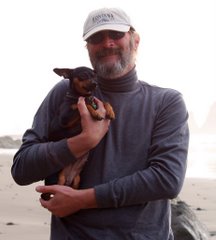Arizona Countryside
10/27/2014
North of Wickenburg, Arizona
I don't know how much time I spent scrambling up that hill and looking in various places, but in time the hiding spot became obvious, and I found the cache. This was a fairly normal sized cache, hidden in a Tupperware sandwich container, but there was no writing instrument in the box. Of course I had none with me either, so I was not able to sign the log. I did take a photograph of the container in case anyone questioned my claim to have found the cache.
Standing up, I faced one of my worst fears--going downhill on slippery ground. Fortunately, from this vantage point I saw what I had not seen climbing the hill. There was a very clear trail from the hiding spot back to the sidewalk. I didn't have to scramble down on all fours, the way I had gone up. But somehow, even though I was wearing shoes, I managed to bruise my left foot and by the time I made it back to the motel, I could barely walk. A month later, that injury still troubles me at times.
Kevin returned shortly after my adventure, so we packed up the truck and headed home. With no desire on either of our parts to follow the same route we had taken southbound, we headed northwest, instead, driving toward Wickenburg, a town sixty miles northwest of Phoenix, but still in Maricopa County. Wickenburg is the southern terminus of US 93, and it was our goal to drive 93 all the way home--well at least to where we would have to turn onto Montana 200 to get to Plains.
We've made the drive between Phoenix and Wickenburg several times, and I don't see anything scenic about the route. This time we took a different highway, and I still didn't see anything worth mentioning, but once on 93 heading toward Las Vegas, we started climbing into the mountains and the desert showed its pretty face.
Proposed Interstate 11
(U.S. Highway 93)
10/27/2014
South of Hoover Dam, Arizona
Between Wickenburg and Hoover Dam, we kept seeing signs indicating that our beloved US 93 would possibly be renamed Interstate 11. I gathered that someone felt it beneficial to connect Phoenix with Las Vegas by something other than a two-lane mountain road, but in doing my research for this post, I have learned that the proposal goes even further, with the possibility of I-11 reaching from the Mexican border to the Canadian, probably following US 95 from Vegas north. When this will actually happen remains to be seen. The highway is just in feasibility studies at present.
We stopped at Bullhead City, Nevada for lunch, and following a meal that was way too heavy in carbohydrates, we stopped in the parking lot long enough for me to take some photos of Lake Mead, a body of water that is dangerously low thanks to the ongoing drought the West is experiencing. While I was standing there, camera in hand, a sight-seeing helicopter took off from the edge of the parking lot and seemed to drop right on top of me. Yes, of course I got pictures even as I wondered if the thing was going to fall out of the sky. But no, it righted itself and took off on what has to be one of the shortest helicopter tours around. We didn't check to see what the five minute ride cost, but frankly, after getting a private helicopter tour of the Grand Canyon a few years ago, I'm kind of spoiled. This ride was much too short, in my opinion, as the 'copter was landing back in the parking lot as we drove off.
Water, Rocks, Helicopter
10/27/2014
Hoover Dam, Nevada
We spent as little time in Vegas as possible, getting off the highway only to refuel the truck, and in a short while, we were leaving Interstate 15 and heading north again on US 93. This section was the only part of 93 new to me. The highway itself runs from Wickenburg to the Canadian border north of the town of Eureka, Montana. It is the most heavily traveled highway in the state of Montana, connecting Missoula and Kalispell, with all the Missoula commuters from the Bitterroot Valley driving it daily, not to mention all the folks headed to Flathead Lake which borders the highway. A good many Glacier National Park visitors also drive 93. North of the international border, the highway becomes British Columbia 93, and when it crosses the Rockies into Banff National Park, it becomes Alberta 93, extending past the Columbia Ice Fields to meet up with the Yellowhead Highway north of Jasper, Alberta. I've driven every mile of the highway from its northern end west of Edmonton to Wells, Nevada, and again from Las Vegas to its southern end at Wickenburg. Never before had I caught the section between Wells and Vegas.
North of I-15, we crossed into Lincoln County, one of two Nevada counties I had never visited. I'll have to go back, because this time, with the exception of a couple quick stops in the the town of Caliente, we didn't really do any sight seeing. Caliente itself caught our attention first for the size of the Union Pacific Railroad Station there, and second for a beautiful old DeSoto parked for sale alongside the highway. Judging by the station, Caliente was once a destination stop, probably because of the hot springs that gave the town its name. Today that station houses the city library, other public offices, and a museum/gallery, according to Wikipedia. I couldn't say as the closest we got to it was parked alongside the highway so I could take this picture.
Union Pacific Station
10/27/2014
Caliente, Nevada
The DeSoto was well worth the time it took to photograph as well, and it is for sale, but I have more vehicles than I can care for myself, so I sent the picture off to my friend Ken who is looking to buy an older DeSoto. Who knows what will become of that.
The seat of Lincoln County is Pioche, a town we drove through without stopping. If I'm to have a photographic record of the Court House, I'll have to return to Pioche. Lincoln County itself was a late addition to Nevada, formed in 1866, two years after statehood. In its original configuration, Nevada's eastern border was miles west of what it is today. Two separate additions were made to the state, taking land from Utah Territory and what would become Arizona. Lincoln County originally included Las Vegas, as Clark County wasn't formed until 1908.
Rock Formation
10/27/2014
White Pine County, Nevada
White Pine County lies north of Lincoln, and was the only other county I'd never seen in Nevada. We crossed into White Pine in the early evening, with the intent of reaching the county seat, Ely, and there spending the night. Ely, where US 93 crosses US 50, is an unusually large town, with several impressive structures. We found a small, mom-and-pop motel which suited us just fine, and had a surprisingly mediocre dinner in the old jail. One building set behind a park was brightly illumined, and I should have taken a picture. The next morning, the White Pine County Courthouse was not nearly as photogenic. Ely (and according to Wikipedia it is pronounced EE-lee, not Ee-Ligh) is definitely on my return trip list, and not just because it is the town where Pat Nixon was born. The climactic scene in one of my favorite movies, Rat Race, was filmed there. Ely, I'll be back!


















